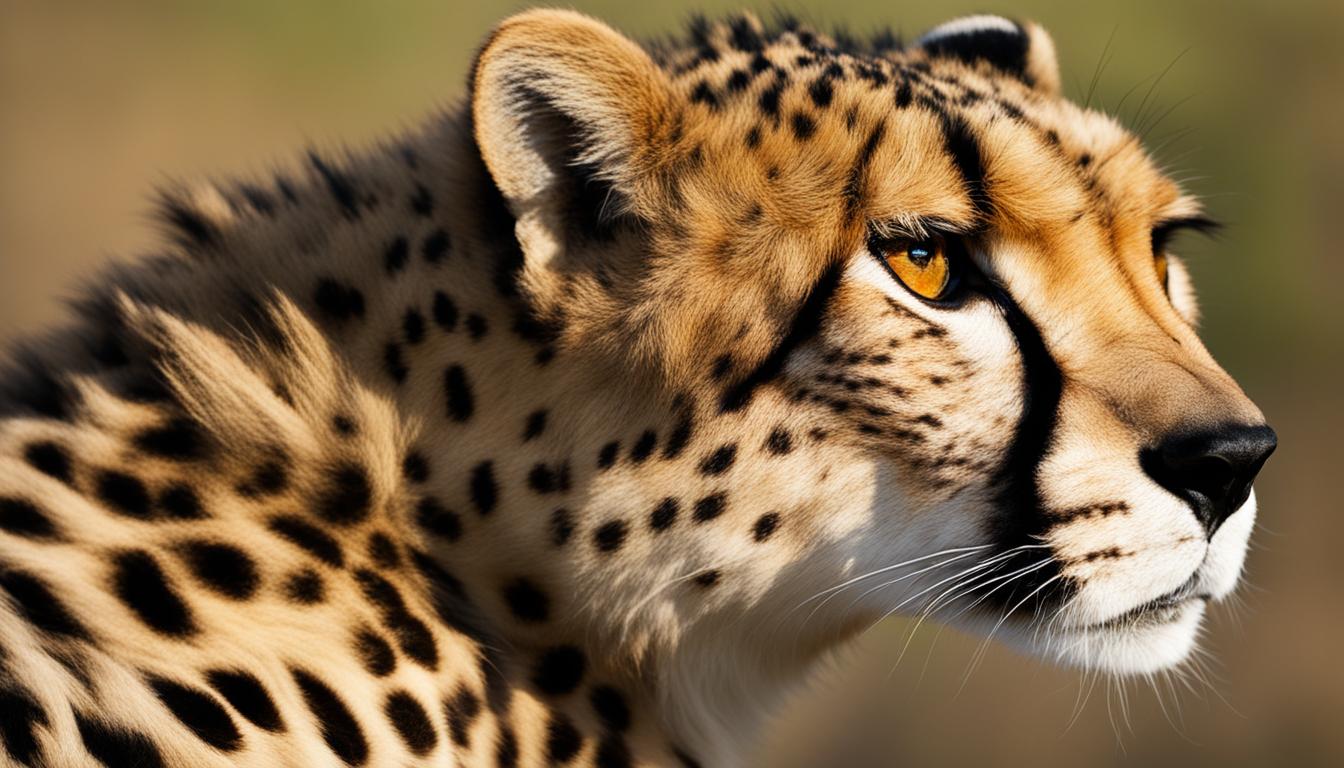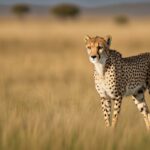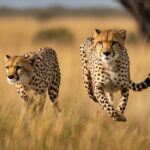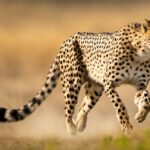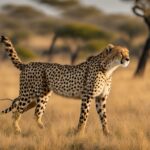Cheetahs, with their magnificent fur and captivating coloration, possess a set of characteristics that are not only aesthetically pleasing but also crucial for their survival in the wild. Their fur serves various purposes, from providing camouflage to aiding in communication and hunting strategies. Let’s delve into the fascinating world of cheetah fur and explore its many remarkable qualities.
The cheetah’s tawny upper coat of fur, adorned with black spots, enables them to seamlessly blend into their environment, making them less visible to potential prey and predators alike. These distinctive patterns of spots, combined with the cheetah’s slender body shape, create a remarkable camouflage that allows them to approach their prey undetected.
But the cheetah’s fur goes beyond just its striking appearance. The black tear markings beneath their eyes serve a practical purpose: they not only protect against the sun’s harsh glare but also aid in focusing on their fast-moving targets. Additionally, cheetah kittens possess a unique fur coloration resembling that of a honey badger, providing them with essential camouflage and protection against potential threats.
Furthermore, the cheetah’s fur plays a significant role in their social and reproductive behaviors. Each cheetah has a distinct pattern of spots, serving as a form of identification among individuals. These spots also break up the cheetah’s outline, making it more challenging for predators to pinpoint their exact location.
Interestingly, cheetah fur color variations exist, resulting from genetic mutations. One such variation is the rare king cheetah, which displays a different coat pattern. These variations provide insights into the evolutionary history of cheetahs and highlight the role of genetics in shaping their fur.
In conclusion, the cheetah’s fur is more than just a visual spectacle. Its coloration, patterns, and adaptability contribute to their survival and success as a species. By understanding the role of cheetah fur, we can better appreciate the remarkable adaptations these magnificent animals possess and work towards their conservation and long-term survival.
Cheetah Fur Adaptations for Speed and Survival
The fur of a cheetah has evolved to provide unique adaptations that contribute to its exceptional speed and survival in the African savannah. These adaptations include characteristics that enable the cheetah to move swiftly, regulate body temperature, and camouflage effectively.
Firstly, the cheetah’s fur is short and coarse, which reduces drag and allows for smoother movement during high-speed chases. This streamlined fur minimizes air resistance, enabling the cheetah to reach incredible speeds of up to 70 miles per hour in just a few seconds. The cheetah’s body is designed for speed, and its fur plays a crucial role in facilitating rapid acceleration and agility.
In addition to aiding in speed, the cheetah’s fur also contributes to its survival by helping with temperature regulation. The hot African savannah can reach scorching temperatures, but the cheetah’s fur acts as an insulating layer that helps keep the animal cool. The fur traps air and provides insulation from the heat, preventing overheating during intense pursuits.
Furthermore, the cheetah’s fur serves as a form of camouflage, allowing it to blend seamlessly into its surroundings. The tawny coloration and black spots on its fur help the cheetah to conceal itself among the golden grasses of its habitat, making it easier to approach prey without being detected. This camouflage is essential for the cheetah’s success as an ambush predator, allowing it to initiate close-range attacks on unsuspecting prey.
Overall, the cheetah’s fur adaptations for speed and survival make it a supremely adapted predator. Its short and coarse fur reduces drag, assists with temperature regulation, and provides effective camouflage, all of which contribute to its remarkable hunting prowess in the African wilderness.
Table: Cheetah Fur Adaptations for Speed and Survival
| Adaptation | Function |
|---|---|
| Short and coarse fur | Reduces drag and allows for smoother movement during high-speed chases |
| Insulating layer | Helps regulate body temperature and prevents overheating |
| Camouflage | Enables the cheetah to blend into its surroundings and approach prey undetected |
The significance of cheetah fur markings
Cheetahs are known for their distinctive fur markings, which serve multiple purposes in their survival and communication. The black spots on a cheetah’s fur are not only visually striking but also play a crucial role in their daily lives.
Each cheetah has a unique pattern of spots, similar to a human fingerprint. These individual markings allow cheetahs to identify each other and distinguish between individuals within their social groups. The spots also aid in camouflage, as they break up the cheetah’s outline and make it more difficult for predators or prey to detect them.
Furthermore, the spots on a cheetah’s fur create visual confusion, making it challenging for predators to pinpoint the cheetah’s exact location. This gives the cheetah a valuable advantage in avoiding potential threats and remaining hidden in their environment.
In conclusion, the significance of cheetah fur markings cannot be overstated. These unique patterns serve as both a means of identification and camouflage, allowing cheetahs to thrive in their natural habitat. The evolution of these markings over time has shaped the cheetah’s survival strategies, making them one of the most iconic and successful predators in the animal kingdom.
Cheetah fur and its role in hunting strategies
The cheetah’s fur plays a crucial role in their hunting strategies. With its remarkable adaptability and camouflage, the fur enables the cheetah to blend seamlessly into its surroundings, providing a strategic advantage in stalking and ambushing prey. The unique coat pattern of the cheetah helps it to remain unnoticed, allowing it to get closer to potential targets without raising suspicion.
The cheetah’s fur not only helps it to blend in with the grassy landscape but also allows for swift movement during a chase. The short, coarse fur reduces drag, enabling the cheetah to reach incredible speeds while maintaining agility. This, combined with the cheetah’s long, slender body and powerful muscles, makes it one of the fastest land animals on the planet.
By effectively camouflaging itself, the cheetah can approach its prey undetected, minimizing the risk of alerting them and increasing the chances of a successful hunt. This hunting strategy requires precise timing, agility, and the ability to maintain a high level of focus. The cheetah’s fur plays a vital role in supporting these skills and maximizing their effectiveness in the pursuit of food.
Cheetah fur and its adaptability
The adaptability of the cheetah’s fur is remarkable. It allows the cheetah to adjust its camouflage depending on the environment it finds itself in. Whether stalking prey in the open grasslands or navigating through dense brush, the cheetah’s fur adapts to provide optimal camouflage, ensuring it remains hidden from potential threats and increasing its chances of a successful hunt.
| Environment | Fur Adaptation |
|---|---|
| Open grasslands | Tawny coloration with black spots for blending in with the yellow-brown grass |
| Dense brush | Lighter and more dispersed spots to mimic the dappled sunlight and shadows in the vegetation |
This ability to adapt their fur coloration gives cheetahs a significant advantage in varying habitats, allowing them to remain hidden from both prey and predators alike.
The Evolution of Cheetah Fur
Over millions of years, the evolution of cheetah fur has resulted in remarkable adaptations and variations. Genetic mutations have played a significant role in shaping the coat color and patterns of these magnificent animals. One of the rare coat color variations is the king cheetah, which exhibits a unique and striking pattern due to genetic differences. This evolution of cheetah fur provides valuable insights into the history and development of this species.
The genetic mutations that give rise to different coat color variations are products of natural selection. These variations in cheetah fur can occur due to changes in pigmentation genes, resulting in distinct coat patterns. The tawny upper coat with black spots is the most common fur coloration among cheetahs. However, variations in coat color and pattern can occur, providing individuals with unique characteristics and adaptations.
The evolution of cheetah fur is closely linked to the survival and success of the species. The distinctive coat coloration, whether it be the traditional tawny with black spots or the rare king cheetah pattern, serves as a form of camouflage in their natural habitat. The ability to blend into the surrounding environment enhances their hunting strategies by allowing them to approach prey undetected. Additionally, the unique fur markings of individual cheetahs contribute to their social structure, helping them communicate with other members of their species.
| Evolutionary Significance | Genetic Mutations |
|---|---|
| Provides insights into the development of coat color variations | Changes in pigmentation genes |
| Enhances camouflage and hunting strategies | Distinctive coat patterns aid in blending into the environment |
| Contributes to social structure and communication | Unique fur markings help identify individuals and facilitate interactions |
“The evolution of cheetah fur showcases nature’s incredible ability to adapt and optimize survival strategies. Through genetic mutations and variations in coat color, cheetahs have developed remarkable adaptations that have allowed them to thrive in their environments.”
Understanding the evolution of cheetah fur is essential for conservation efforts and the long-term survival of these incredible animals. By studying the genetic makeup and adaptive characteristics of their fur, scientists can gain valuable insights into the cheetah’s evolutionary history. This knowledge can inform conservation strategies aimed at protecting and preserving cheetah populations for future generations.
Cheetah fur and its role in communication
Cheetah fur markings and patterns play an essential role in communication among these majestic animals. By observing the unique patterns on a cheetah’s fur, other cheetahs can determine important information about an individual, such as their age, sex, and social status. These markings serve as a visual language that helps establish and maintain the social structure within cheetah populations.
“The markings on a cheetah’s fur are like a secret code that only they can understand,” says Dr. Sarah Thompson, a wildlife biologist specializing in cheetah behavior. “They provide vital information about an individual’s place in the hierarchy and facilitate social interactions.”
During mating rituals, male cheetahs rely heavily on their fur patterns to communicate their intentions to potential mates. The markings on their fur become more prominent, creating a visually striking display that signals their readiness to mate. Similarly, territorial disputes among male cheetahs often involve intimidating displays of their fur markings, serving as a warning to rivals to stay away.
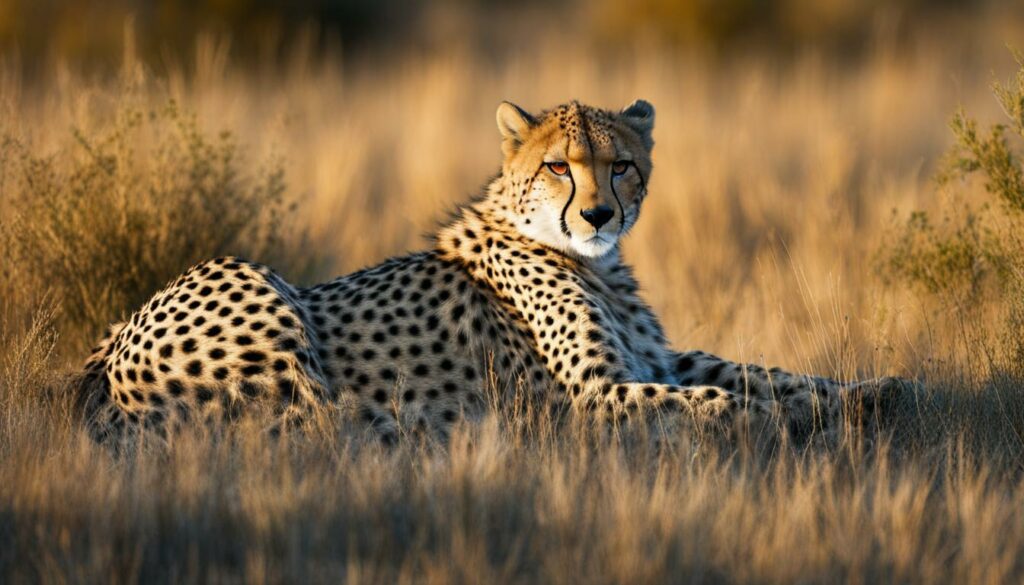
In addition to social communication, cheetah fur patterns also have an impact on camouflage. The distinct markings on their fur help break up their outline, making it harder for prey to detect them. This enables cheetahs to approach their target stealthily, increasing their chances of a successful hunt. Their fur acts as a natural disguise, allowing them to blend seamlessly into the grassy savannah where they hunt.
| Fur Markings | Meaning |
|---|---|
| Single dots on the body | Indicates a juvenile cheetah |
| Thicker and more numerous spots | An adult cheetah |
| Darker and deeper patterns | Signifies a dominant individual |
| Lighter and less pronounced markings | Indicates a subordinate cheetah |
Understanding the language of cheetah fur is vital for researchers and conservationists studying these incredible creatures. By unraveling the intricate meanings behind the patterns, we gain valuable insights into their social dynamics and behavior. Ultimately, this knowledge can contribute to the ongoing efforts to protect and preserve cheetah populations in the wild.
Conclusion
The fur and coloration of cheetahs play a crucial role in their survival and success as a species. These remarkable animals have evolved unique adaptations and characteristics that enable them to thrive in their natural environment.
The cheetah’s fur patterns, characterized by tawny coats with black spots, allow them to blend seamlessly into their surroundings. This natural camouflage helps them approach prey without being detected, giving them a strategic advantage in hunting.
Moreover, the cheetah’s fur serves as a form of communication among individuals. The distinctive patterns and markings on their fur provide important information about their age, sex, and social status. This communication is especially significant during mating rituals and territorial disputes, helping cheetahs establish and maintain their social structure.
Understanding the role and characteristics of cheetah fur is vital for conservation efforts. By studying and preserving the unique adaptations of cheetahs, we can contribute to the long-term survival of these magnificent creatures and ensure their continued presence in our world.
How do the fur and coloration of cheetahs aid in their adaptation to their environments?
Cheetahs, unlike leopards, adaptation to environments focuses on speed and stealth. Their spotted fur blends with the grasses of the savanna, breaking their outline to camouflage effectively as they stalk or chase prey, maximizing their hunting prowess in wide-open spaces.
How does the cheetah’s fur and coloration help in its hunting strategies?
The cheetah’s fur and coloration play a crucial role in its hunting strategies. The spotted coat acts as camouflage, allowing the cheetah to blend into its surroundings and ambush prey. Additionally, their keen eyesight, which is essential for successful hunting, underscores the importance of the role of vision in hunting.
FAQ
What role does the cheetah’s fur and its coloration play?
The cheetah’s fur provides camouflage, temperature regulation, and plays a role in their social and reproductive behaviors.
What are the black spots on a cheetah’s fur for?
The black spots on a cheetah’s fur serve multiple purposes, including identification, breaking up their outline, and creating visual confusion for predators.
How does the cheetah’s fur help with their hunting strategies?
The cheetah’s fur helps them blend into their surroundings, allowing them to get closer to their prey without being noticed.
How has the evolution of cheetah fur occurred?
The cheetah’s coat color variations, such as the king cheetah, result from genetic mutations and provide insights into their evolutionary history.
What role do the markings and patterns on a cheetah’s fur play?
The markings and patterns on a cheetah’s fur serve as a form of communication, helping other cheetahs determine age, sex, and social status.
What is the significance of cheetah fur in their survival as a species?
The cheetah’s fur is integral to their survival and success, enabling them to excel in hunting strategies, communicate with other cheetahs, and blend into their environment.

